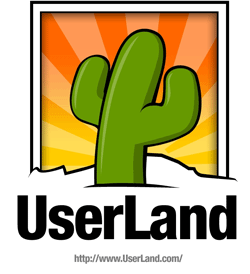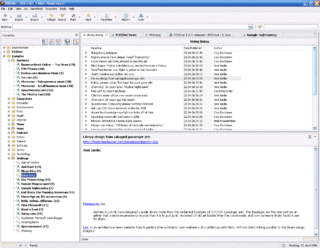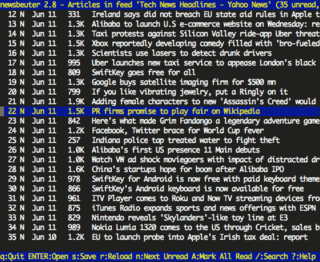Feed format
A photofeed may be in the RSS 2.0 or Atom format.
| | This section needs expansion. You can help by adding to it. (December 2016) |
A photofeed is a web feed that features image enclosures. They provide an easy, standard way to reference a list of images with title, date and description.
Photofeeds are RSS enclosures of image file formats, similar to podcasts (enclosures of audio file formats).
A photofeed may be in the RSS 2.0 or Atom format.
| | This section needs expansion. You can help by adding to it. (December 2016) |
Enclosed images may be in the JPEG, GIF or PNG formats.
| | This section needs expansion. You can help by adding to it. (December 2016) |
A photofeed can contain:
A photofeed aggregator is a piece of software that accepts subscribable RSS 2.0 syndication feeds and downloads or precaches higher resolution images (rather than thumbnails) for later viewing, such as when offline. There are not a tremendous number of photo aggregators yet. (please add)

Dave Winer is an American software developer, entrepreneur, and writer who resides in New York City. Winer is noted for his contributions to outliners, scripting, content management, and web services, as well as blogging and podcasting. He is the founder of the software companies Living Videotext, Userland Software and Small Picture Inc., a former contributing editor for the Web magazine HotWired, the author of the Scripting News weblog, a former research fellow at Harvard Law School, and current visiting scholar at New York University's Arthur L. Carter Journalism Institute.

UserLand Software is a US-based software company, founded in 1988, that sells web content management, as well as blogging software packages and services.
RSS is a web feed that allows users and applications to access updates to websites in a standardized, computer-readable format. Subscribing to RSS feeds can allow a user to keep track of many different websites in a single news aggregator, which constantly monitor sites for new content, removing the need for the user to manually check them. News aggregators can be built into a browser, installed on a desktop computer, or installed on a mobile device.

RSSOwl is a discontinued news aggregator for RSS and Atom news feeds. It is written in Java and built on the Eclipse Rich Client Platform which uses SWT as a widget toolkit to allow it to fit in with the look and feel of different operating systems while remaining cross-platform. Released under the EPL-1.0 license, RSSOwl is free software.

The name Atom applies to a pair of related Web standards. The Atom Syndication Format is an XML language used for web feeds, while the Atom Publishing Protocol is a simple HTTP-based protocol for creating and updating web resources.
On the World Wide Web, a web feed is a data format used for providing users with frequently updated content. Content distributors syndicate a web feed, thereby allowing users to subscribe a channel to it by adding the feed resource address to a news aggregator client. Users typically subscribe to a feed by manually entering the URL of a feed or clicking a link in a web browser or by dragging the link from the web browser to the aggregator, thus "RSS and Atom files provide news updates from a website in a simple form for your computer."
OpenSearch is a collection of technologies that allow the publishing of search results in a format suitable for syndication and aggregation. Introduced in 2005, it is a way for websites and search engines to publish search results in a standard and accessible format.
Media RSS (MRSS) is an RSS extension that adds several enhancements to RSS enclosures, and is used for syndicating multimedia files in RSS feeds. It was originally designed by Yahoo! and the Media RSS community in 2004, but in 2009 its development has been moved to the RSS Advisory Board. One example of enhancements is specification of thumbnails for each media enclosure, and the possibility to enclose multiple versions of the same content.
RSS enclosures are a way of attaching multimedia content to RSS feeds with the purpose of allowing that content to be prefetched. Enclosures provide the URL of a file associated with an entry, such as an MP3 file to a music recommendation or a photo to a diary entry. Unlike e-mail attachments, enclosures are merely hyperlinks to files. The actual file data is not embedded into the feed. Support and implementation among aggregators varies: if the software understands the specified file format, it may automatically download and display the content, otherwise provide a link to it or silently ignore it.

In computing, a news aggregator, also termed a feed aggregator, content aggregator, feed reader, news reader, or simply an aggregator, is client software or a web application that aggregates digital content such as online newspapers, blogs, podcasts, and video blogs (vlogs) in one location for easy viewing. The updates distributed may include journal tables of contents, podcasts, videos, and news items.
Podcasts, previously known as "audioblogs", have roots dating back to the 1980s. With the advent of broadband Internet access and portable digital audio playback devices such as the iPod, podcasting began to catch hold in late 2004. Today there are more than 115,000 English-language podcasts available on the Internet, and dozens of websites available for distribution at little or no cost to the producer or listener.
A search aggregator is a type of metasearch engine which gathers results from multiple search engines simultaneously, typically through RSS search results. It combines user specified search feeds to give the user the same level of control over content as a general aggregator.
Windows RSS Platform, included in Internet Explorer 7 and later and Windows Vista and later is a platform that exposes feed handling and management to Windows applications. The RSS support in Internet Explorer is built on the Windows RSS Platform.
RSS tracking is a methodology for tracking RSS feeds.
The following is a comparison of RSS feed aggregators. Often e-mail programs and web browsers have the ability to display RSS feeds. They are listed here, too.
WebP is a raster graphics file format developed by Google intended as a replacement for JPEG, PNG, and GIF file formats. It supports both lossy and lossless compression, as well as animation and alpha transparency.

Newsbeuter was a text-based news aggregator for Unix-like systems. It was originally written by Andreas Krennmair in 2007 and released under the MIT License. The program is aimed at power users and strives to be "the mutt of rss feed readers." It supports the major feed formats including RSS and Atom and can import and export subscription lists in the OPML format. Newsbeuter (podbeuter) also supports podcasting and synchronization. As of 2017, the project is no longer maintained; the original developers advise users to switch to Newsboat, an actively maintained fork of Newsbeuter.

RSS Guard is a free and open-source news aggregator for web feeds and podcasts. It is written in C++ and uses Qt, which allows it to fit with the look and feel of different operating systems while remaining cross-platform. It includes a file downloader, advanced network proxy configuration, and supports external media viewing tools.